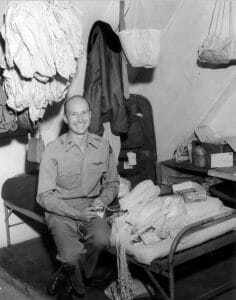Born in Salt Lake City, Utah, Halvorsen wanted to fly, and earned his pilot’s license in 1941, and joined the Civil Air Patrol. With World War II raging, he joined the U.S. Army Air Forces in 1942, and was assigned to transport operations in the South Atlantic. When the Berlin Airlift (“Operation Vittles”) was begun in 1948 as a counter to the Soviet blockade, he was assigned to Germany to fly food to the city in a C-54 cargo plane.

During his time off, Halvorsen noticed children were gathering at Tempelhof, the airfield where the Airlift planes were based. “I met about thirty children at the barbed wire fence that protected Tempelhof’s huge area,” he remembered later. “They were excited and told me that ‘when the weather gets so bad that you can’t land, don’t worry about us. We can get by on a little food, but if we lose our freedom, we may never get it back.’” He noticed the kids had “absolutely nothing,” and all he had to give them was two sticks of gum. But he had an idea: he gathered candy, and dropped it on little hand-made parachutes from his plane to the gathered children. Then his commander found out about what he was doing. There were no reprimands: Lt. Gen. William Tunner ordered the project expanded into “Operation Little Vittles”. Word of the project spread quickly, and American citizens gathered candy and sent it to Berlin to be dropped to the kids. By the time the airlift ended, more than 23 tons of candy was dropped using more than 250,000 hand-made parachutes.
Lt. Halvorsen became famous as the “Candy Bomber”, and women sent him marriage proposals. But he had a “girl back home” — Alta Jolley — and they were married when he got back to the U.S. in 1949. The U.S. Air Force offered to send him to school, where he earned bachelor’s and master’s degrees in Aeronautical Engineering from the University of Florida. He went on to be the project engineer for cargo aircraft research and development, served the Air Command and Staff College at Maxwell Air Force Base, then assigned to the Air Force Systems Command, where he researched and developed various space projects, including the Titan III launch vehicle program. Halvorsen took numerous other assignments, including being posted back to West Germany, then the Pentagon, the Satellite Control Facility at Vandenberg Air Force Base, and Commander of the 7350th Air Base Group — at Tempelhof. He retired in 1974, and in 2014 was awarded the Congressional Gold Medal. Col. Gail Seymour Halvorsen died in Provo, Utah, on February 16. He was 101 and, in a tribute after hearing the news, Berlin’s mayor, Franziska Giffey, said that “Halvorsen’s deeply human act has never been forgotten.”
Another tribute to Col. Halvorsen, performed by The Mormon Tabernacle Choir (narrated by Tom Brokaw):
